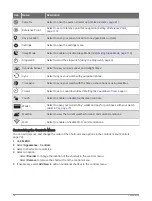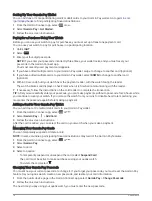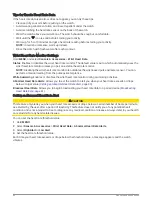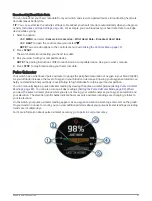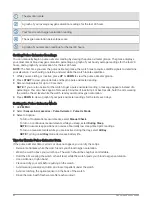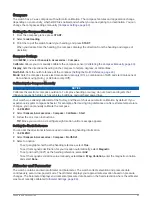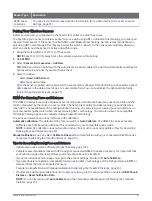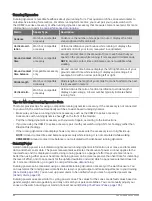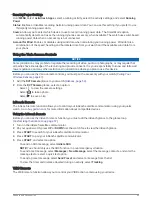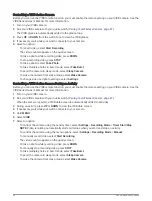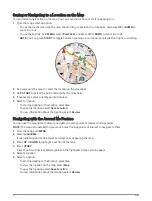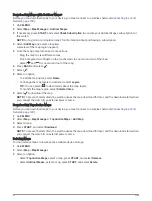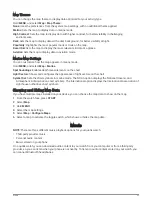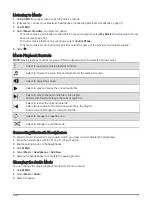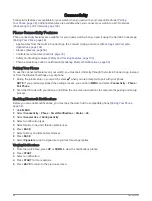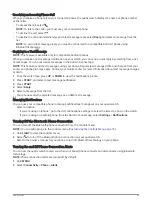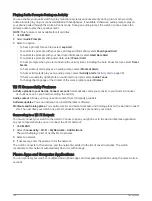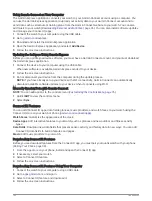
Running Dynamics
Running dynamics is real-time feedback about your running form. Your quatix watch has an accelerometer to
calculate five running form metrics. For all six running form metrics, you must pair your quatix watch with
the HRM-Pro series accessory or other running dynamics accessory that measures torso movement. For more
information, go to
garmin.com/performance-data/running
Metric
Sensor Type
Description
Cadence
Watch or compatible
accessory
Cadence is the number of steps per minute. It displays the total
steps (right and left combined).
Vertical oscil
lation
Watch or compatible
accessory
Vertical oscillation is your bounce while running. It displays the
vertical motion of your torso, measured in centimeters.
Ground contact
time
Watch or compatible
accessory
Ground contact time is the amount of time in each step that you
spend on the ground while running. It is measured in milliseconds.
NOTE: Ground contact time and balance are not available while
walking.
Ground contact
time balance
Compatible accessory
only
Ground contact time balance displays the left/right balance of your
ground contact time while running. It displays a percentage. For
example, 53.2 with an arrow pointing left or right.
Stride length
Watch or compatible
accessory
Stride length is the length of your stride from one footfall to the next.
It is measured in meters.
Vertical ratio
Watch or compatible
accessory
Vertical ratio is the ratio of vertical oscillation to stride length. It
displays a percentage. A lower number typically indicates better
running form.
Tips for Missing Running Dynamics Data
This topic provides tips for using a compatible running dynamics accessory. If the accessory is not connected
to your watch, the watch automatically switches to wrist-based running dynamics.
• Make sure you have a running dynamics accessory, such as the HRM-Pro series accessory.
Accessories with running dynamics have on the front of the module.
• Pair the running dynamics accessory with your watch again, according to the instructions.
• If you are using the HRM-Pro series accessory, pair it with your watch using ANT+ technology, rather than
Bluetooth technology.
• If the running dynamics data display shows only zeros, make sure the accessory is worn right-side up.
NOTE: Ground contact time and balance appears only while running. It is not calculated while walking.
REMEMBER: Ground contact time balance is not calculated with wrist-based running dynamics.
Running Power
Garmin running power is calculated using measured running dynamics information, user mass, environmental
data, and other sensor data. The power measurement estimates the amount of power a runner applies to the
road surface, and it is displayed in watts. Using running power as a gauge of effort may suit some runners
better than using either pace or heart rate. Running power can be more responsive than heart rate for indicating
the level of effort, and it can account for the uphills, downhills, and wind, which a pace measurement does not
do. For more information, go to
garmin.com/performance-data/running
Running power can be measured using a compatible running dynamics accessory or the watch sensors. You
can customize the running power data fields to view your power output and make adjustments to your training
(
). You can set up power alerts to be notified when you reach a specified power zone
(
).
Running power zones are similar to cycling power zones. The values for the zones are default values based on
gender, weight, and average ability, and may not match your personal abilities. You can manually adjust your
zones on the watch or using your Garmin Connect account (
Setting Your Power Zones, page 105
).
88
Sensors and Accessories



